Commercial roofs are designed to withstand various weather conditions and protect the building’s interior. However, leaks can still occur due to a range of factors. In this guide, we’ll explore eight common causes of commercial roof leaks and how roofers and roof ventilators play a crucial role in addressing these issues.
Table of Contents
Age and Wear
Commercial roofs, especially those with older materials, can develop leaks over time due to wear and tear. Constant exposure to sunlight, rain, snow, and temperature fluctuations can weaken Metal Roofing Ottawa, causing cracks, gaps, and deterioration. Roofers specializing in commercial roofing can assess the condition of the roof and recommend repairs or replacements to address age-related leaks.
Poor Installation
Improper installation of roofing materials is a significant cause of roof leaks in commercial buildings. If the Ottawa Roofing system, including membranes, flashing, and seals, is not installed correctly, it can lead to vulnerabilities and water penetration points. Experienced roofers understand the importance of proper installation techniques and can rectify any installation errors to prevent leaks.
Lack of Maintenance
Neglecting regular maintenance and inspections can contribute to roof leaks in commercial buildings. Accumulated debris, clogged gutters, and damaged roofing components can compromise the integrity of the roof and create opportunities for water infiltration. Roofers recommend routine maintenance schedules to identify and address potential issues before they escalate into leaks.
Ponding Water
Flat or low-slope commercial roofs are prone to ponding water, where water accumulates and does not drain properly. Ponding water can exert excessive pressure on the roof membrane, leading to leaks, deterioration, and structural damage. Roofers can install roof ventilators and improve drainage systems to mitigate ponding water issues and prevent leaks.
Flashing and Sealant Failures
Flashing and sealants are essential components that prevent water from seeping into vulnerable areas such as roof edges, penetrations, and joints. Over time, flashing can deteriorate, and sealants can degrade, resulting in leaks. Roofers inspect flashing and sealant integrity during maintenance visits and repair or replace them as needed to maintain a watertight seal.
Roof Penetrations
Commercial roofs often have various penetrations, including HVAC units, vents, pipes, and skylights. Improperly sealed penetrations or damaged flashing around them can allow water to enter the building. Roofers specialize in sealing penetrations effectively and ensuring they are watertight to prevent leaks and protect interior spaces.
Storm Damage
Severe weather events, such as heavy rain, hailstorms, high winds, and snow accumulation, can cause damage to commercial roofs and result in leaks. Roofers offer emergency repair services to address storm-related damage promptly and prevent further water intrusion. They assess the extent of damage, make temporary repairs if necessary, and schedule permanent repairs to restore the roof’s integrity.
Inadequate Ventilation
Poor roof ventilation can contribute to moisture buildup, condensation, and eventual leaks in commercial buildings. Roof ventilators play a crucial role in maintaining proper airflow, reducing humidity levels, and preventing moisture-related problems. Roofers assess ventilation systems, install or upgrade roof ventilators, and recommend ventilation solutions to improve indoor air quality and protect the roof from leaks.
Conclusion
In conclusion, commercial roof leaks can result from various factors, including age, poor installation, lack of maintenance, ponding water, flashing and sealant failures, roof penetrations, storm damage, and inadequate ventilation. Roofers specializing in commercial roofing have the expertise, tools, and techniques to identify the causes of leaks and implement effective solutions. By addressing these issues proactively and working with experienced roofers and roof ventilators, commercial building owners can maintain a watertight and durable roof that protects their assets and occupants.
